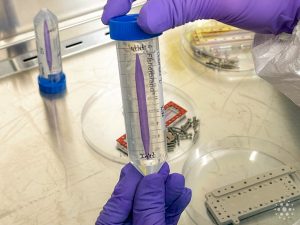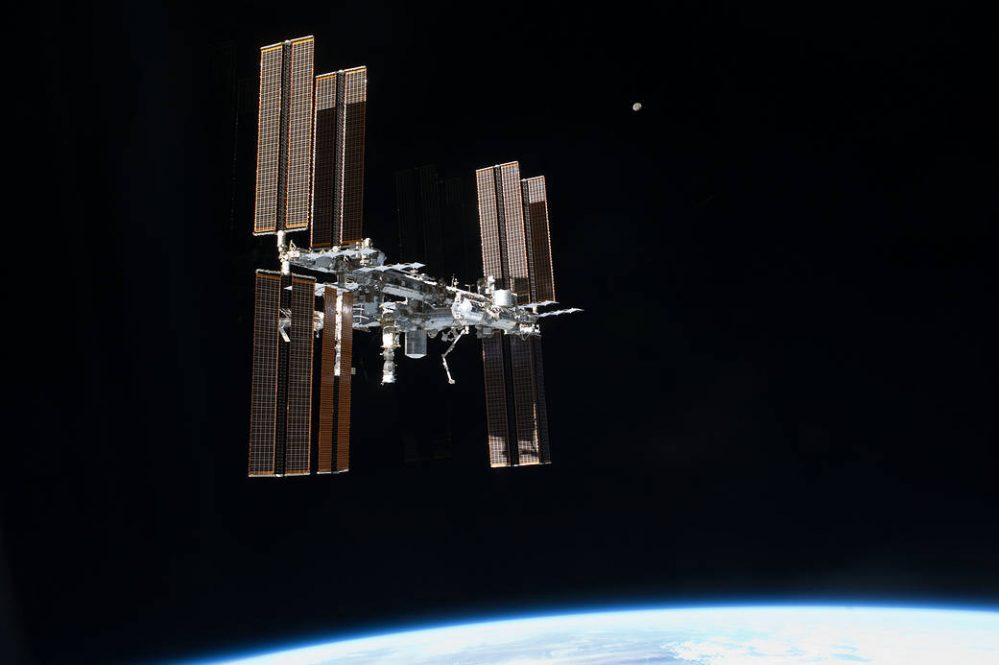You may not think of the vast, fascinating expanses of the universe as a manufacturing site. But UConn TIP startup LambdaVision has found success manufacturing their technology in microgravity on the International Space Station (ISS).
LambdaVision has been working with the ISS, NASA, and Space Tango to explore how microgravity could improve the manufacturing process for their protein-based artificial retina.
LambdaVision’s technology contains 200 layers of bacteriorhodopsin on a mesh scaffold that can be implanted using a routine surgical procedure behind the eye of a patient suffering from loss of sight due to age-related macular degeneration (AMD) or retinitis pigmentosa (RP).
The key is that this technology is most effective if all the layers, which are applied one at a time in the manufacturing process, are completely uniform.
The normal forces of gravity on earth can cause particles to settle or liquids to evaporate, which could lead to imperfections and increase instability of the artificial retina. In microgravity, however, solutions are entirely homogenous as molecules are spread out evenly.
So far, LambdaVision has sent their technology up to space five times, using CubeLabs from their implementation partner, Space Tango. Their first launch was on SpaceX 16 in December 2018. The most recent was on the SpaceX Crew-4 in April 2022.

LambdaVision has developed and validated a microgravity manufacturing method through these missions and have successfully manufactured their 200-layer films on the ISS.
LambdaVision recently got their samples from the latest microgravity experiments back for analysis. Initial analysis of the films indicates that they are more uniform than the controls manufactured on Earth. Further evaluation of these films is ongoing.
One major advantage of the microgravity manufacturing approach is that the implants are only coated on one side. Single-sided coating is required for the performance of the protein-based artificial retinas, and avoiding double-sided coating using a terrestrial manufacturing approach is challenging.
“This is a big success for us,” Nicole Wagner, LambdaVision president and CEO says.
Another advancement is that LambdaVision has validated hardware to make the process autonomous. With the first missions, they had to manually intervene throughout the manufacturing cycles. Now, the Space Tango CubeLabs run almost entirely on their own.
With each launch, LambdaVision seeks to validate their manufacturing process and test different parameters to see if changing the time spent in each stage, for example, improves the overall outcome.
LambdaVision is continuously working to ensure their microgravity process follows good manufacturing practices.
“[We’re looking at] How do you make this as reproducible and as high quality as possible,” Wagner says. “So that’s another big part of what we’ve been doing.”
LambdaVision is also developing assays and laboratory techniques to assess the quality and function of the artificial retinas and measure the effects of the microgravity environment.
“We’ve made a lot of progress but there’s still work to be done,” Wagner says. “We’re continuing to look at the parameters, we’re continuing to develop these assays. But having made the 200-layer film in microgravity is a big milestone.”
LambdaVision has plans to be aboard three more launches in the next year with the next launch happening on Space X Crew 5 in October.
This work is supported by a $5 million NRA commercialization grant from NASA.



